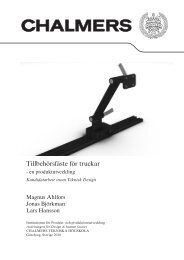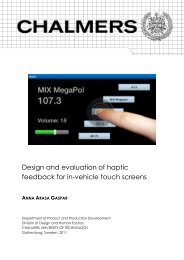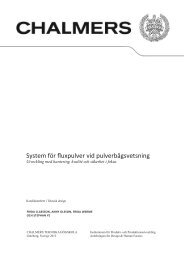Thesis - Teknisk Design
Thesis - Teknisk Design
Thesis - Teknisk Design
- No tags were found...
Create successful ePaper yourself
Turn your PDF publications into a flip-book with our unique Google optimized e-Paper software.
Conceptual <strong>Design</strong> of Temporary Exhibition Platform and Smart Grid Exhibitionfor Siemens Urban Sustainability CentreTheorythe form of wind and hydro power. Wind power is growingfast today with a growth rate of about 25% per year (TheWindpower, 2011) and will become a large contributorto the world’s electricity supply in the near future. Directsolar power can be turned into electricity from eitherphotovoltaic cells, or from thermal solar power plants.The problem with integrating more renewable powergeneration into an energy system is that those sourcesare highly fluctuating (except for hydropower with dams).Electricity supply today is adapted to the demand of theusers and needs to be more reliable than renewable intermittentenergy sources. To allow for the expansion ofrenewable energy, the supply and demand relation mustbe balanced. Storage capacity is needed in the grid whenthere is excess power and the demand for electricity mustbe managed to match the supply. This calls for a flexibleelectricity price in combination with a grid that cancommunicate with smart home products (World EnergyCouncil, 2010).Energy security and efficiencyIn many places around the world there is already a problemwith old grids not being able to supply the electricityaccording to demand. Blackouts and brownouts in theelectricity grid are costly and this problem grows as theworld’s energy demand increases and the fossil sourcesare running out. Power quality also becomes moreproblematic when more and more disturbing objects andsensitive equipment are connected to the grid. This callsfor a smarter control of the electricity system to assure asafe and reliable supply of electricity of the right quality(International Energy Agency, 2011).Today’s electricity infrastructure is designed to meetthe highest level of demand and during non-peak hoursthe system is underutilised. If demand was levelled, thisexcess power capacity would not be needed. Smart gridtechnology can manage this by providing incentives forconsumers to shift consumption from peak hours to offpeak hours. This is achieved by providing consumerswith information about supply and electricity price, aswell as through smart automated solutions which helpsconsumers make the most profitable choices (Larsson& Ståhl, 2011). This will open up a new era of consumerchoice and enable household equipment, such as washingmachines, to be programmed to start when the electricityprice is low, normally during night time (Vattenfall R&D,2010). Similarly an electric car battery can work as powerstorage and provide a household with energy when theelectricity price is high. Such development will requiretechnical equipment and the grid to communicate, aswell as smart software solutions to make the consumerdecisions as easy as possible (European TechnologyPlatform, 2011 ).2.1.3 Steps towards a smart gridSteps that need to be taken towards a smart grid differa lot between regions. What steps that need to be takenare generally depending on the current situation in theDemand responseIn the traditional electricity grid,balance is kept by adapting the supplyto the projected demand. In a future gridwith more fluctuating renewable energy sourcesthis relation will change into a Demand Responsesystem, where the consumption is controlled by pricingsignals to adapt the demand to the currentsupply. A demand response system will requiresmart technology that meters andoptimises consumptions to evenout the demand.8
















